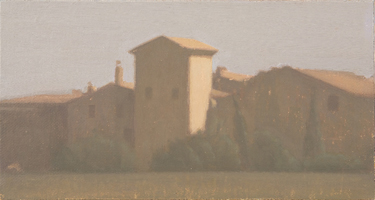
From Afar
Israel Hershberg's landscapes at Marlborough
by Maureen Mullarkey
THE DEEP AND DELIBERATE IMPRESS OF THE UMBRIAN LANDSCAPE on Israeli painter Israel Hershberg yields work that, at its best, comes close to an incarnate elegy. These vistas, clouded by mists of distance and the more enigmatic veils of time, call to mind those lines of Thomas Gray: “ Now fades the glimmering landscape on the sight./ And all the air a solemn stillness holds.” Hershberg is drawn to the ancient fields and undulating hills that greeted Etruscan eyes. An annual visitor to Umbria, he pays homage to the castellos and walled cities that stand as emblems of the flowering of art that exalted the Italian middle ages. Here are elegant glimpses of place names that St. Francis and Thomas Acquinas knew, as well as Giotto, Luca Signorelli and Perugino.
 |
| Israel Hershberg, Fratta Todina from Afar (2003) |
From Afar is Hershberg's third solo exhibition with Marlborough, and his first in eight years. It consists of only ten paintings created since 2003. Cultivation takes time. The delicacy, precision and carefully calibrated imprecisions of these paintings, even the smallest, are not the work of a day. A keen observer and fastidious craftsman, Hershberg has little interest in the plein air sketch. Each of these works is a lovingly worked studio recreation of sites initially viewed long-distance through a camera lens.
Contrary to popular prejudice on the subject, the camera is a creative tool like any other. In the hands of a painter as knowledgeable as Hirshberg, it can be a very liberating instrument. He uses it to capture composition, freeing time and attention for the subtler elements of construction within the larger design. Hershberg is in his element handling light, balancing tonalities, finessing the edges of forms, and deciding which details to include, which to eliminate or merely suggest.
Suggestion is major factor in the loveliness of each of these intimate scenes of the Umbrian hill towns. Fratta Todina from Afar ! (2003) melts the lateral expanse of several low, contiguous buildings into a single running block of warm shadow. The sunny plane of a tall rectangular structure breaks the darkling line and secures it to the ground plane. Fratta Todina from Afar II (2005) and Spinetta from Afar (2009) dissolve the plane changes between buildings in a spacious span of white light. Linear precision surrenders to a tactile impasto that provides an illusion of solidity to balance the soft-focus immateriality of the scene.
Todi from Afar (2009) is particularly appealing. The zigzagging chiaroscuro of this small-scaled roofscape-sunlight and shadow interlocked like pieces in a jigsaw puzzle-plays dramatically against barely discernible hills in the grayed distance. Here, the entire field of vision dances. It bears a vivacity that escapes the monumental, more detailed Italian landscapes. Despite the patterning of fields dotted by green groves and lines of trees, both Aria Umbria I (2003-4) and Aria Umbria II (2007-9), each 98 inches long, have a static quality that fixes the image-as if preserved in amber-on the canvas. The oval format of the later painting simulates the look of a matted photograph, reinforcing the sense of it as a studied souvenir rather than a felt response to the living place.
The overall elegance of this show and Hershberg's command of his craft is undeniable. Yet something inauthentic drags at the ensemble. Look for the key to what goes awry in the unfortunate title of a small homage to Jean Baptiste Corot's celebrated painting of Papigno. Claiming to have found the precise location from which Corot viewed Papigno, Hershberg names this stilled blur of muted greens The C-Spot (2005-6). Some, undoubtedly, will find that clever. But serious viewers are likely to see a tag taken from female porn magazines as a come-on to buyers with pockets deeper than their sensibilities. The double entendre defeats it own object by injecting a note of artificiality into these hazy, indeterminate forms. It loosens collective purchase on the element of truth that accompanies what we call beautiful.
Storied sites of saints and medieval painters alike are, by now, museum pieces supported by tourism and the hospitality industry. What were once vibrant loci of a long-ago renewal of painting have become what Louis Bouyer said of museums: “cultural refrigerators where apparent life is actually preserved in a state of death.” At heart, these Umbrian towns are artifacts of a civilization that has said a definitive goodbye to the animating spirit of the age that produced them. Therein is the elegiac quality inherent in both landscapes and townscapes. Fratta Todina, Todi, Spineta and Monte Melino-churchyards in which Judeo-Christian identity, no longer a unifying or motivating element of culture, lies entombed.
Perhaps that is why Tel Kakun (2005-2007), a verdant panorama of crop-growing in northern Israel, strikes me as the most vital painting here. It is not a votive offering to memory. It makes no effort to seduce. Rather, it is a straightforward testament to fertility achieved under near-impossible conditions. A seemingly endless stretch of clear greens extends as far as the eye can see until it recedes into the far hills. Tel Kakun is hardly a political painting, certainly not in any crude sense of the term. Yet its communicative vigor asserts the élan of a nation that continues to fructify the desert.
Israel Hershberg is one of the finest painters of his generation. He shares Antonio López-Garcia's serene eye, technical grace, and gift for conveying an ageless atmosphere. But the Spanish master kept his eye on the living realities of his own city and terrain. Hershberg's painting is most compelling when he does the same.




“Israel Hershberg: From Afar” at Marlborough Chelsea (545 W. 25th Street, 212-925-6190).
This review first appeared in American Arts Quarterly, Winter, 2010.
Copyright 2005 Maureen Mullarkey







